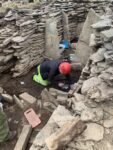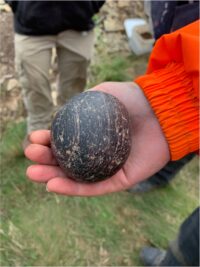 Two polished stone balls have been discovered in a Neolithic chambered tomb on the Tresness peninsula of the Orkney island of Sanday. The 5,500-year-old tomb is rapidly eroding, and archaeologists have been working assiduously to salvage any artifacts and fully document the structure before the cliff it is on collapses into the sea.
Two polished stone balls have been discovered in a Neolithic chambered tomb on the Tresness peninsula of the Orkney island of Sanday. The 5,500-year-old tomb is rapidly eroding, and archaeologists have been working assiduously to salvage any artifacts and fully document the structure before the cliff it is on collapses into the sea.
The Tresness tomb is one of fewer than 20 examples of a stalled cairn, a slab-built passage grave with a central chamber that is divided into compartments along its sides like horse stalls and topped with an barrow. It has five compartments. The southernmost one is partially eroded, but archaeologists believe it was the last cell at the end of the tomb.
In the Bronze Age, a round cairn was built on top of the Neolithic tomb, truncating it and stripping it of its original roof. When excavations resumed this year after last year’s COVID interruption, archaeologists removed the Bronze Age remains to reveal the full extent of the remaining Neolithic tomb.
 The polished stone balls were found in chamber one. They are about the size of cricket balls, and are finely carved and finished. The first is in excellent condition, perfectly spherical and glossy. The second has cracked along a band in the sandstone. That will repaired by conservators.
The polished stone balls were found in chamber one. They are about the size of cricket balls, and are finely carved and finished. The first is in excellent condition, perfectly spherical and glossy. The second has cracked along a band in the sandstone. That will repaired by conservators.
Only 20 stone balls from this period have been found on Orkney (about 500 have been discovered in Scotland as a whole), and of these, only a few have been archaeologically excavated from a burial site.
Carved stone balls were symbols of power and were probably used, along with perhaps maces, to inflict blunt force trauma to the head. One skull from the Cuween passage tomb on Orkney shows signs of such injury.
Two similar cases were also found by Dr Dave Lawrence at the Rowiegar chambered cairn on the island. At Tomb of the Eagles at Isbister, he found that both males and females, young and old, were harmed in this way.
The team has created 3D models of the Tresness stalled cairn before and after the removal of the Bronze Age round cairn.
Here is the tomb as it looked the first week of excavations, composed from photos taken on August 22nd, 2021.
Here it is a week ago with the round barrow removed: